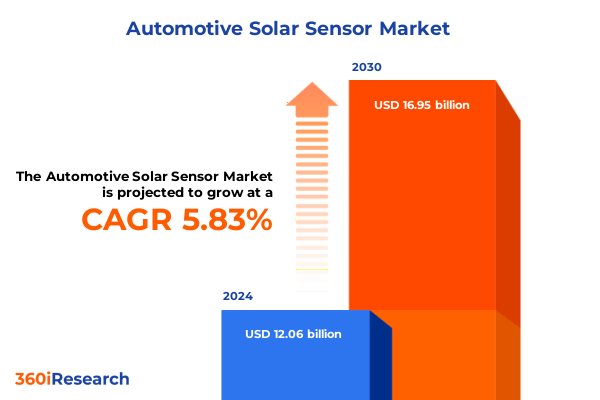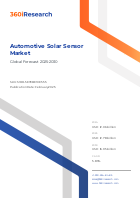The Automotive Solar Sensor Market size was estimated at USD 12.06 billion in 2024 and expected to reach USD 12.78 billion in 2025, at a CAGR 5.83% to reach USD 16.95 billion by 2030.

Introduction: Overview of Automotive Solar Sensor Market
The automotive solar sensor market has emerged as a critical enabler for next-generation vehicle functionality, addressing an array of needs from climate control precision to energy harvesting for auxiliary systems. As automakers and tier-1 suppliers pursue enhanced passenger comfort, improved safety, and greater energy efficiency, solar sensors provide reliable measurement of ambient light, temperature fluctuations, and photonic energy potential. This executive summary offers a comprehensive overview of market dynamics, highlights key technological advances, and underscores how regulatory shifts and tariff policies are reshaping the competitive landscape. By examining core segmentation categories, regional variations, and leading industry players, decision-makers will gain actionable intelligence for strategic planning and investment prioritization.
Transformative Shifts Reshaping the Automotive Solar Sensor Landscape
Recent years have witnessed transformative shifts redefining how solar sensors integrate into vehicle architectures. First, the convergence of autonomous driving and advanced driver-assistance systems has elevated the demand for precise ambient light and motion detection, enabling adaptive headlight control and glare mitigation. Second, growing consumer preference for sustainable mobility has accelerated the adoption of energy harvesting modules that supplement battery systems, reducing overall electrical load. Third, miniaturization driven by thin-film and silicon-based sensor innovations has allowed seamless dashboard and roof mounting, optimizing cabin aesthetics without compromising performance. Additionally, the rise of digital sensor technology with IoT connectivity ensures real-time data sharing, enabling predictive maintenance and over-the-air calibration updates. These shifts underscore a market in flux, where cross-disciplinary integration and system-level design are becoming the new norm.
Assessing the Cumulative Impact of 2025 United States Tariffs
The introduction of new United States tariffs in 2025 has created a ripple effect across global supply chains, compelling manufacturers to reassess sourcing strategies and cost structures. Tariffs targeting photovoltaic and thin-film components have driven procurement teams to diversify supplier portfolios, exploring regional manufacturing hubs to mitigate increased duties. Some tier-1 suppliers have responded by vertically integrating production of cadmium telluride and copper indium gallium selenide thin-film layers, while others are leveraging tariff exemptions for electric vehicle components to offset additional expenses. This policy environment has also steered research and development budgets toward silicon-based alternatives and organic sensor materials, which face lower duty rates. Ultimately, tariff pressures are accelerating localization trends and fostering innovation in alternative sensor chemistries.
Key Segmentation Insights Across Multiple Dimensions
Breaking the market down by sensor type reveals four primary categories: electro-chemical sensors prized for humidity detection, photovoltaic sensors harnessing ambient light for energy harvesting, pyroelectric sensors tuned for thermal flux, and thermophotovoltaic sensors optimized for high-temperature environments. Material composition further delineates organic sensors built on polymers and small molecule compounds; silicon-based sensors using monocrystalline and polycrystalline silicon; and thin-film sensors employing cadmium telluride or copper indium gallium selenide. Application domains span climate control systems with humidity and temperature sensors, energy harvesting via direct power supply or solar-battery integration, infotainment systems featuring audio control and display panel interfaces, lighting control through adaptive lighting or dimming technologies, and safety and security systems encompassing air quality monitoring and proximity detection. Installation location considerations include exterior roof and window mounting as well as interior dashboard and roof placements. Vehicle type segmentation covers commercial vehicles (heavy and light), electric vehicles (battery electric and plug-in hybrid), and passenger vehicles (coupes, hatchbacks, sedans, SUVs). Integration types range from fully integrated vehicle networks to standalone modules. End users include aftermarket suppliers, OEMs, and repair and maintenance service providers. Technology preferences are split between analog sensor platforms and digital solutions incorporating IoT-based data transmission and wireless connectivity. Finally, functional features address motion detection, conversion efficiency rates, and rapid reaction times, collectively driving performance differentiation.
This comprehensive research report categorizes the Automotive Solar Sensor market into clearly defined segments, providing a detailed analysis of emerging trends and precise revenue forecasts to support strategic decision-making.
- Sensor Type
- Material Type
- Application
- Installation Location
- Vehicle Type
- Integration Type
- End User
- Technology Used
- Functional Feature
Key Regional Insights Influencing Market Evolution
Regional dynamics reflect distinct adoption drivers and regulatory frameworks. In the Americas, demand is propelled by stringent emissions standards and strong uptake of electric vehicles, encouraging investment in energy harvesting and adaptive climate control modules. Europe, Middle East & Africa exhibit a dual focus: European markets emphasize safety and infotainment integration under rigorous pedestrian protection regulations, while Middle Eastern fleets prioritize durability in extreme climates. African markets, though smaller, demonstrate growing interest in aftersales retrofit opportunities. In the Asia-Pacific region, fast-growing automotive production hubs in China, India, and Southeast Asia lead volumes, with local manufacturers optimizing cost-effective material blends and forging partnerships to access advanced digital sensor platforms. Each region’s policy landscape and consumer preferences shape distinct trajectories for solar sensor adoption.
This comprehensive research report examines key regions that drive the evolution of the Automotive Solar Sensor market, offering deep insights into regional trends, growth factors, and industry developments that are influencing market performance.
- Americas
- Asia-Pacific
- Europe, Middle East & Africa
Key Company Insights and Competitive Dynamics
Competitive intensity remains high among established semiconductor and automotive component manufacturers. Allegro Microsystems and Infineon Technologies AG leverage specialized photonic expertise to deliver high-precision photovoltaic modules, while NXP Semiconductors NV and Texas Instruments Incorporated integrate digital processing and IoT connectivity to enable smart sensor networks. Continental AG, Denso Corporation, and Robert Bosch GmbH enrich vehicle architectures with platforms that unify climate control, lighting, and safety functionalities. Tier-2 specialists such as Amphenol Corporation, Littelfuse, Inc., and TE Connectivity Ltd. focus on robust material sourcing and scalable manufacturing, whereas emerging players like Hunan Rika Electronic Tech Co., Ltd. and SOLAR MEMS Technologies S.L. drive cost innovations in thin-film deposition and organic sensor materials. Additionally, Honeywell International, Inc., Sensata Technologies, Inc., and Panasonic Holdings Corporation consistently expand R&D portfolios, pursuing rapid reaction times and enhanced conversion rates. Together, these companies are shaping the competitive frontier for automotive solar sensors.
This comprehensive research report delivers an in-depth overview of the principal market players in the Automotive Solar Sensor market, evaluating their market share, strategic initiatives, and competitive positioning to illuminate the factors shaping the competitive landscape.
- Allegro Microsystems
- Amphenol Corporation
- Continental AG
- Denso Corporation
- Honeywell International, Inc.
- Hunan Rika Electronic Tech Co., Ltd.
- Infineon Technologies AG
- IST AG
- Littelfuse, Inc.
- Luksens
- NXP Semiconductors NV
- Panasonic Holdings Corporation
- Robert Bosch GmbH
- Sensata Technologies, Inc.
- Sivara Enterprises
- SOLAR MEMS Technologies S.L.
- TE Connectivity Ltd.
- Texas Instruments Incorporated
- Valeo
- Variohm Holdings
Actionable Recommendations for Industry Leaders
Industry leaders should pursue a multi-pronged approach to capitalize on emerging opportunities. First, diversify component sourcing by establishing regional manufacturing partnerships to mitigate tariff impacts and logistical constraints. Second, prioritize R&D investments in hybrid material platforms-combining silicon-based cores with thin-film overlays-to balance performance with cost efficiency. Third, embed digital sensor technology with IoT connectivity to unlock predictive analytics and over-the-air calibration, driving value for fleet operators and OEMs. Fourth, collaborate with infotainment and safety system integrators to deliver unified user experiences and streamline certification processes. Fifth, cultivate aftermarket channels by offering retrofit kits for legacy vehicles, addressing demand in markets with slower new-vehicle turnover. By executing these strategies, companies can secure stronger value propositions and achieve sustainable differentiation.
Explore AI-driven insights for the Automotive Solar Sensor market with ResearchAI on our online platform, providing deeper, data-backed market analysis.
Ask ResearchAI anything
World's First Innovative Al for Market Research
Conclusion: Strategic Imperatives for the Road Ahead
As the automotive industry advances toward electrification, autonomy, and connected mobility, solar sensor capabilities will become increasingly mission-critical for energy management, passenger comfort, and safety. Regulatory shifts, regional variances, and competitive pressures necessitate agile strategic responses, agile supply chain frameworks, and continuous technological innovation. Organizations that effectively integrate advanced sensor platforms with digital ecosystems will unlock new revenue streams and reinforce competitive moats. Leadership teams should leverage the insights presented here to inform roadmap planning, cross-functional collaboration, and targeted investment decisions. By doing so, they will be well positioned to deliver the next generation of intelligent, energy-efficient vehicles.
This section provides a structured overview of the report, outlining key chapters and topics covered for easy reference in our Automotive Solar Sensor market comprehensive research report.
- Preface
- Research Methodology
- Executive Summary
- Market Overview
- Market Dynamics
- Market Insights
- Cumulative Impact of United States Tariffs 2025
- Automotive Solar Sensor Market, by Sensor Type
- Automotive Solar Sensor Market, by Material Type
- Automotive Solar Sensor Market, by Application
- Automotive Solar Sensor Market, by Installation Location
- Automotive Solar Sensor Market, by Vehicle Type
- Automotive Solar Sensor Market, by Integration Type
- Automotive Solar Sensor Market, by End User
- Automotive Solar Sensor Market, by Technology Used
- Automotive Solar Sensor Market, by Functional Feature
- Americas Automotive Solar Sensor Market
- Asia-Pacific Automotive Solar Sensor Market
- Europe, Middle East & Africa Automotive Solar Sensor Market
- Competitive Landscape
- ResearchAI
- ResearchStatistics
- ResearchContacts
- ResearchArticles
- Appendix
- List of Figures [Total: 34]
- List of Tables [Total: 1034 ]
Call-To-Action: Engage with Ketan Rohom for the Full Report
To explore these insights in greater depth and obtain a comprehensive market research report tailored to your strategic objectives, please contact Ketan Rohom, Associate Director of Sales & Marketing, at [email protected] or via phone at +1-XXX-XXX-XXXX.

- How big is the Automotive Solar Sensor Market?
- What is the Automotive Solar Sensor Market growth?
- When do I get the report?
- In what format does this report get delivered to me?
- How long has 360iResearch been around?
- What if I have a question about your reports?
- Can I share this report with my team?
- Can I use your research in my presentation?




